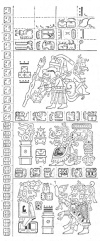
Sacred Texts Native American Maya Index Previous Next
Buy this Book at Amazon.com

Yucatan Before and After the Conquest, by Diego de Landa, tr. William Gates, [1937], at sacred-texts.com
In all the towns of Yucatan it was the custom to have at each of the four entrances to the town two heaps of stones, one in front of the other; that is, at the east, west, north and south; and here they celebrated the two festivals of the 'unlucky' days, in the following manner.
For the year whose Dominical letter was
 Click to enlarge |
This being done, the chiefs, the priest and the men of the town, assembled and having the road clean and prepared, with arches and green branches, as far as the two heaps of stone where the statue was, there they gathered most devoutly; on arriving there the priest incensed the statue with forty-nine grains of ground maize, mixed with incense; then the nobles put their incense into the brazier of the idol, and incensed it. The ground maize alone was called sacah, and that of the lords chahalté.
Thus incensing the image, they cut off the head of a fowl, and presented it as an offering. When all had done this, they placed the image on a wooden standard called kanté, placing on his shoulders an angel as a sign of water and of a good year, and these angels they painted so as to make them frightful in appearance. Then they carried it with much rejoicing and dancing to the house of the principal, where there was the other statue of Bolon-tz’acab.
[paragraph continues] From the house of this principal they brought out to the road, for the chiefs and the priest, a drink made of 415 grains of toasted maize (which they call picula kakla, of which all drank. On arrival at the house they set the image they were carrying in front of the statue of the demon they had there, and then made many offerings of food and drink, of meat and fish; these offerings were given to whatever strangers there were there; and to the priest they gave a leg of venison.
Others drew blood by cutting their ears and anointing therewith a stone image they had there, of the demon Kanal-acantun. They molded a heart of bread and another of calabash seeds, and offered those to the image of the demon Kan-uvayeyab. They kept this statue and image through those fateful days, and perfumed them with their incense, and with the ground maize and incense. They believed that if they did not perform these ceremonies, certain sicknesses would come on them in the ensuing year. When these fatal days were over they took the statue of Bolon-tz’acab to the temple, and the image to the eastern entrance where the next year they would go for it; there they left it and went to their houses to do what was their part in celebrating the new year.
These ceremonies over, and the evil spirit exorcised according to their deluded beliefs, they looked on the coming year as a good one, because it was ruled by the character Kan and the bacab Hobnil; and of him they said that in him there was no sin as in his brothers, and because of that no evils would come upon them. But since they often did so come, the evil one provided ceremonies therefor, so that when they happened they might throw the blame on the ceremonies or celebrants; and thus they continued always deluded and blind.
It was then commanded to make an idol called Itzamná-kauil, and place it in the temple. Then in the temple court they burned three
 |
62:* The illustration is a page of the Dresden codex, showing the Kan-uvayeyab ceremonies at the East.